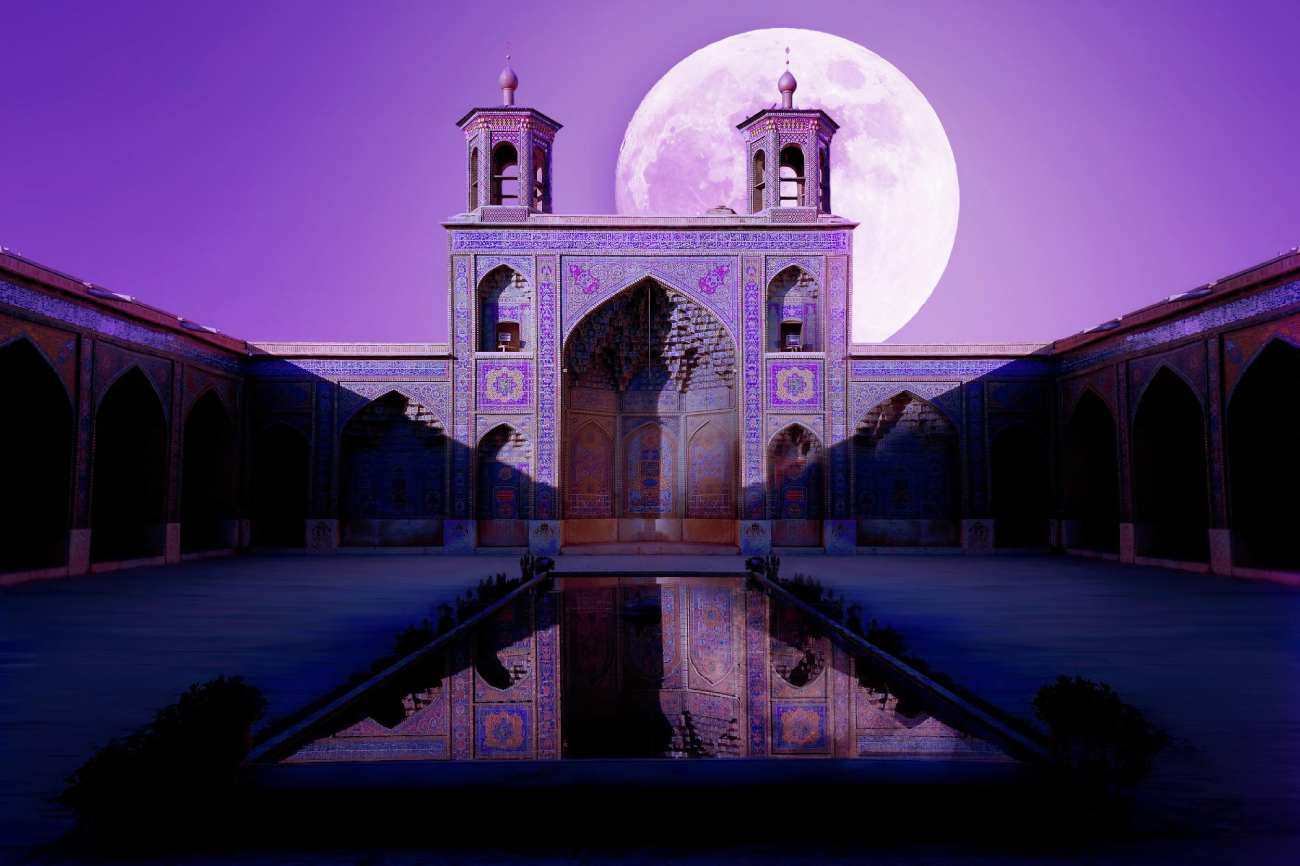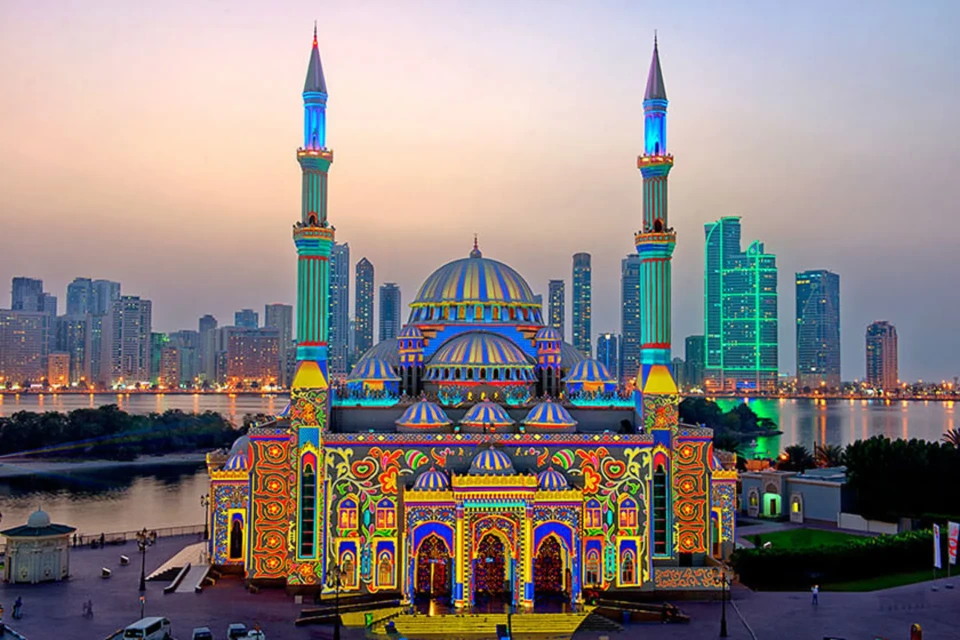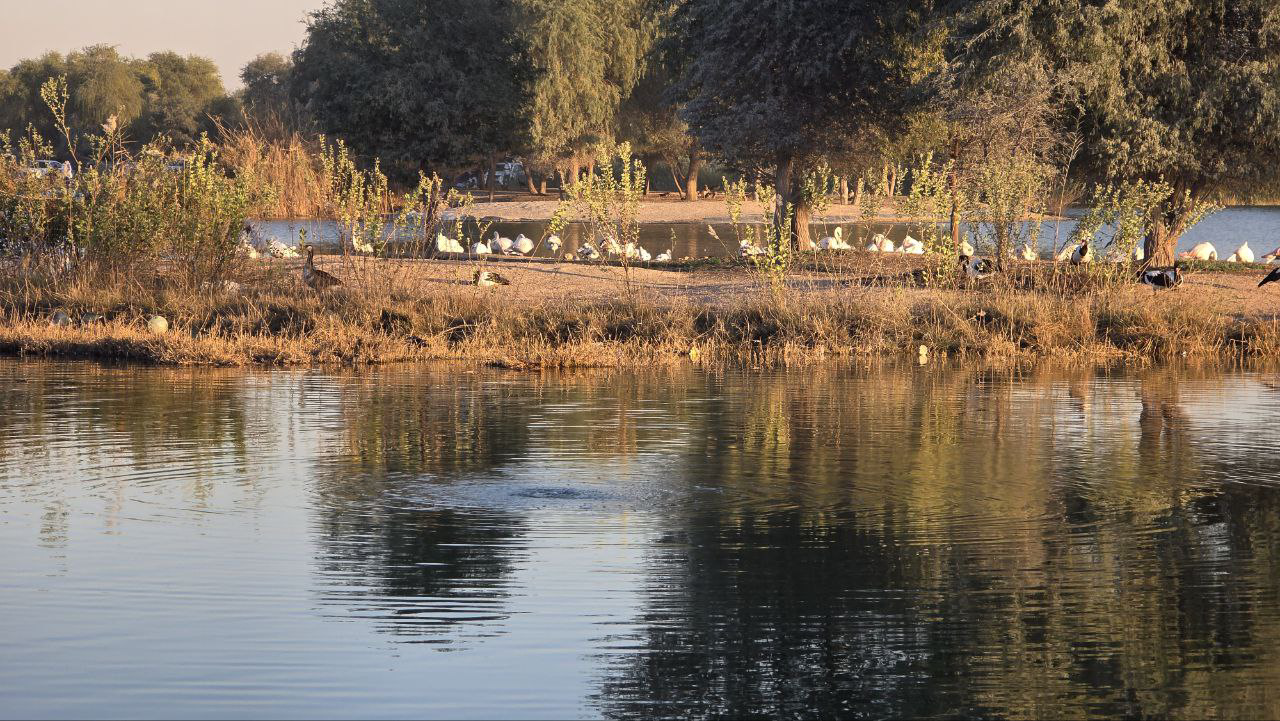10 best cities in Iran for visit & traveling
Iran is a country with a rich history, diverse culture, and stunning landscapes. There are many cities in Iran that offer excellent sightseeing opportunities. Here are 10 of the best cities in Iran for sightseeing:
- Tehran: The capital city is home to numerous historical sites, museums, and bustling bazaars. Don’t miss the Golestan Palace, National Museum of Iran, and the Azadi Tower.
- Isfahan: Known for its stunning Islamic architecture, Isfahan is famous for sites like the Imam Square, Sheikh Lotfollah Mosque, and the stunning Isfahan Grand Bazaar.
- Shiraz: This city is often called the “City of Poets” and is home to the beautiful Nasir al-Mulk Mosque, the ancient Persepolis ruins, and the Tomb of Hafez.
- Yazd: Yazd is famous for its well-preserved historic adobe architecture, including the Jameh Mosque of Yazd and the Yazd Atash Behram (Zoroastrian Fire Temple).
- Persepolis: Although not a city, Persepolis is an ancient archaeological site near Shiraz, showcasing the ruins of the ceremonial capital of the Achaemenid Empire.
- Kashan: This city is known for its stunning historic houses like the Tabatabaei House and the Borujerdi House, along with the beautiful Fin Garden.
- Mashhad: The holiest city in Iran for Shia Muslims, with the stunning Imam Reza Shrine as the major attraction.
- Kerman: A gateway to the desert, Kerman features the stunning Ganjali Khan Complex and the Rayen Citadel.
- Kermanshah : is a city located in western Iran and is the capital of Kermanshah Province. It is known for its historical significance, cultural heritage, and natural beauty
- Qazvin: Known for its historic bazaars and caravanserais, it offers a glimpse into Iran’s Silk Road history, with sites like the Chehel Sotoun Palace and Sa’d al-Saltaneh Caravanserai.
These cities offer a diverse range of cultural, historical, and natural attractions, making them great destinations for sightseeing in Iran. Remember to check travel advisories and local guidelines before planning your trip, as conditions may change.
More information about Tehran
Tehran, the capital of Iran, is a bustling metropolis with a rich history, vibrant culture, and a dynamic urban atmosphere. Here’s an overview of Tehran:
Geography: Tehran is situated in the north-central part of Iran, at the foot of the Alborz Mountains. The city enjoys a picturesque setting, with the mountains providing a stunning backdrop.
History: Tehran’s history dates back to the 13th century, but it began to grow significantly in the 19th century under the Qajar dynasty. It became the capital of Iran in the late 18th century and has played a central role in the country’s development.
Cultural Hub: Tehran is the cultural heart of Iran, home to numerous museums, theaters, galleries, and cultural institutions. The National Museum of Iran, the Museum of Contemporary Art, and the Tehran Museum of Contemporary Photography are just a few examples.
Architectural Landmarks: The city boasts a mix of modern and historic architecture. Notable landmarks include the Golestan Palace, the Azadi Tower, and the Milad Tower, which is one of the tallest telecommunications towers in the world.
Bazaars and Shopping: Tehran has several traditional bazaars where you can explore Iranian handicrafts, carpets, spices, and more. The Grand Bazaar and Tajrish Bazaar are popular shopping destinations.
Cuisine: The city offers a diverse range of Iranian cuisine. You can savor dishes like kebabs, stews, and traditional Persian sweets in local restaurants and teahouses.
Parks and Recreation: Tehran is home to numerous parks and green spaces, including Laleh Park and Mellat Park, where locals go to relax and enjoy outdoor activities.
Traffic and Transportation: Tehran is known for its heavy traffic, but it has a well-developed public transportation system that includes the Tehran Metro and a network of buses. Traffic congestion is a common challenge, especially during peak hours.
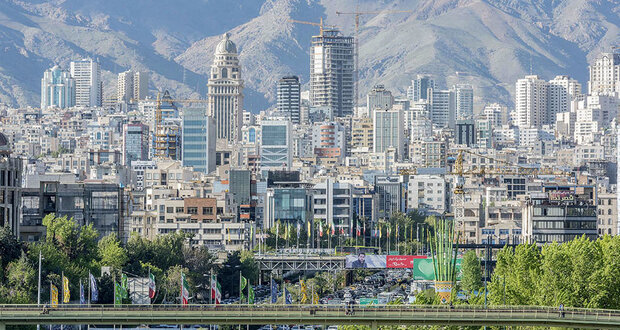
Religious Sites: Tehran has several important religious sites, including the Imam Khomeini Shrine and the Shah Abdol-Azim Shrine, which are significant for Shia Muslims.
Education and Innovation: The city is home to numerous universities and research institutions, making it a hub for education and innovation in Iran. The University of Tehran is one of the country’s most prestigious institutions.
Political and Administrative Center: Tehran is not only the cultural and economic center of Iran but also the political capital. It houses the Iranian government’s administrative offices, including the presidential palace and the parliament.
Challenges: Like many major cities, Tehran faces challenges such as air pollution and traffic congestion. The city’s residents and government are actively working on addressing these issues.
Tehran is a city of contrasts, where the ancient and modern coexist. It’s a place where you can explore Iran’s rich history and culture while also experiencing its contemporary urban lifestyle.
Why Tehran?
Tehran, as the capital of Iran, is a natural starting point for many travelers visiting the country. Here are some reasons why people choose to visit Tehran:
Cultural and Historical Significance: Tehran is the cultural and historical heart of Iran. It’s home to numerous museums, palaces, and historic sites that provide valuable insights into the country’s rich heritage.
Gateway to Iran: For international travelers, Tehran is often the entry point into Iran, as it has the largest and most well-connected international airport in the country, Imam Khomeini International Airport.
Diverse Attractions: Tehran offers a wide range of attractions, from historic sites like the Golestan Palace and the National Museum to contemporary landmarks like the Milad Tower. Visitors can explore both ancient and modern facets of Iran.
Educational and Research Institutions: Tehran is known for its prestigious universities and research institutions. Visitors with academic or research interests may choose to visit these institutions.
Shopping and Markets: The city’s bazaars, including the Grand Bazaar and Tajrish Bazaar, are excellent places to shop for traditional Iranian goods, such as Persian carpets, handicrafts, spices, and textiles.
Cuisine: Tehran boasts a diverse culinary scene, offering traditional Persian dishes and international cuisine. Travelers can savor the rich flavors of Iran’s culinary traditions.
Cultural Events: The city hosts various cultural events, including music concerts, theater performances, and art exhibitions. It’s a hub of cultural activity in Iran.
Political and Administrative Hub: Visitors interested in the political landscape and governance of Iran may find it informative to visit Tehran, where many government offices and institutions are located.
Transportation Hub: Tehran serves as a central transportation hub within Iran. From Tehran, you can easily access other cities and regions in the country by bus, train, or domestic flights.
Diverse Population: Tehran is a diverse and cosmopolitan city where people from various ethnic backgrounds and cultures coexist, making it an interesting place to observe Iran’s multiculturalism.
However, it’s essential to note that while Tehran offers many attractions and serves as a gateway to Iran, travelers may also explore other cities and regions in Iran to experience the country’s diverse culture, history, and natural beauty. The choice to visit Tehran ultimately depends on one’s interests and travel itinerary.
More information about Isfahan
Isfahan, also spelled as Esfahan, is one of Iran’s most historically and culturally significant cities. Often referred to as “Nesf-e Jahan,” which means “Half of the World” in Persian, Isfahan is known for its stunning architecture, vibrant culture, and rich history. Here is more information about Isfahan:
Historical Significance: Isfahan has a long and storied history, dating back over 2,500 years. It served as the capital of Persia during the Safavid dynasty in the 17th century, a period known for its cultural and architectural achievements.
Naghshe Jahan Square: This UNESCO World Heritage-listed square is one of the largest city squares in the world. It’s surrounded by architectural marvels, including the Imam Mosque (Shah Mosque), Sheikh Lotfollah Mosque, Ali Qapu Palace, and the Grand Bazaar. The square is a central point for visitors and a perfect place to start exploring the city.
Imam Mosque (Shah Mosque): This iconic mosque, located on Naghshe Jahan Square, is known for its stunning blue-tiled domes and intricate Islamic geometric designs.
Sheikh Lotfollah Mosque: Adjacent to Imam Mosque, this mosque is celebrated for its unique and delicate architecture, with a soft pinkish hue and intricate tile work.
Ali Qapu Palace: This palace, also on Naghshe Jahan Square, served as a royal residence and an entertainment complex. Visitors can explore the palace’s six floors, with each level showcasing various architectural and decorative features.
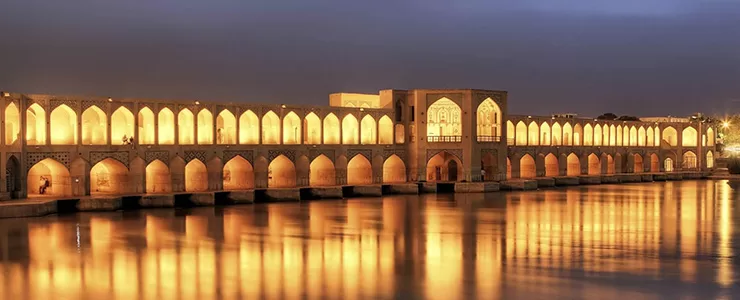
Bridges: Isfahan is known for its picturesque bridges over the Zayandeh Rud River. The Si-o-Seh Pol and Khaju Bridge are both architectural marvels and popular spots for locals and tourists to relax.
Chehel Sotoun Palace: This Safavid-era palace is famous for its twenty wooden columns that are reflected in the pool, creating the illusion of “Forty Columns.” The palace features beautiful frescoes depicting historical events.
Historic Bazaars: Isfahan’s bazaars are bustling centers of commerce and culture. The Grand Bazaar is one of the oldest and largest in Iran, where you can find a wide array of traditional goods.
Jolfa District: This historic Armenian quarter is known for its charming streets, Vank Cathedral (Holy Savior Cathedral), and the Armenian Genocide Memorial.
Cultural and Artistic Activities: Isfahan is a hub for traditional arts, including Persian calligraphy, miniature painting, and carpet weaving. You can find workshops and galleries showcasing these crafts.
Traditional Cuisine: Isfahan offers a taste of traditional Persian cuisine. Try local dishes like Biryani, Gaz (a famous sweet), and the various kebabs and stews.
Natural Beauty: The city is surrounded by scenic natural attractions, including the Zagros Mountains and the Isfahan Province’s deserts and oases.
Isfahan’s cultural richness, stunning architecture, and hospitable atmosphere make it a must-visit destination for anyone exploring Iran. The city’s historical significance and well-preserved landmarks offer a glimpse into the country’s grand past and enduring traditions.
why isfahan
Isfahan is a popular destination in Iran for several compelling reasons:
Historical and Architectural Riches: Isfahan boasts a wealth of historical and architectural treasures, including stunning mosques, palaces, and bridges. The city’s Safavid-era architecture is renowned for its intricate tile work, geometric patterns, and elegant designs. Travelers with an interest in history and art find Isfahan to be a treasure trove of cultural heritage.
Naghshe Jahan Square: Often described as one of the most beautiful squares in the world, Naghshe Jahan Square is the heart of Isfahan. It is surrounded by some of Iran’s most iconic landmarks, making it a prime location for sightseeing and immersing in Persian culture and history.
Cultural Significance: Isfahan played a pivotal role in the Safavid dynasty, which was a period of great cultural and artistic flourishing in Iran. The city remains a cultural hub, with opportunities to explore Persian arts, music, and traditions.
Religious and Spiritual Significance: Isfahan is home to significant religious sites, including the Imam Mosque and the Vank Cathedral. These places of worship hold great importance for both Muslims and Christians.
Bazaars and Craftsmanship: Isfahan’s traditional bazaars offer a unique opportunity to experience Persian craftsmanship, from carpets and textiles to calligraphy and miniature painting. Exploring these markets is a chance to connect with local artisans and shop for authentic Persian products.
Natural Beauty: Beyond its urban attractions, Isfahan is surrounded by beautiful natural landscapes, including the Zayandeh Rud River and the Zagros Mountains. Nature enthusiasts can enjoy both the city’s offerings and its proximity to scenic wilderness.
Culinary Delights: Isfahan offers a taste of authentic Persian cuisine, known for its aromatic rice dishes, kebabs, and stews. Food lovers will find a wide range of traditional and delectable Persian dishes.
Hospitable Locals: Isfahan is known for its friendly and hospitable residents. Visitors often feel welcomed and appreciate the warmth of the local community.
Rich History and Culture: Isfahan’s history as a capital of Persia during the Safavid era has left an enduring mark on the city’s culture, making it a fascinating destination for those interested in Iranian history.
Unique Experiences: Exploring Isfahan provides travelers with unique experiences, from enjoying Persian gardens and traditional teahouses to witnessing local celebrations and festivals.
Ultimately, choosing Isfahan as a travel destination allows visitors to delve into Iran’s history, culture, and architecture. The city’s combination of historical significance and vibrant culture makes it a compelling choice for those seeking an authentic Iranian experience.

More information about Shiraz
Shiraz is a city in southwestern Iran known for its rich cultural heritage, poetic history, and picturesque landscapes. It is often referred to as the “City of Poets” and “City of Gardens” due to its association with famous Persian poets and its many beautiful gardens. Here is an overview of Shiraz:
Historical Significance: Shiraz has a long and storied history dating back over 4,000 years. It was the capital of Persia during the Zand dynasty in the 18th century and is home to various historical sites and architectural wonders.
Poetry and Literature: Shiraz is famously associated with Persian poetry and literature. It was the hometown of some of Iran’s most celebrated poets, including Hafez and Saadi. The tombs of these poets are major cultural landmarks in the city and places of literary pilgrimage.
Hafez Tomb: The tomb of Hafez, one of the most revered Persian poets, is a tranquil place surrounded by beautiful gardens. Locals and tourists often visit to pay their respects, read Hafez’s poetry, and seek inspiration.
Saadi Tomb: The tomb of Saadi, another prominent Persian poet, is a peaceful garden containing his mausoleum. Visitors can explore the garden and reflect on his wisdom.
Nasir al-Mulk Mosque (Pink Mosque): This stunning mosque is famous for its colorful stained glass windows, intricate tile work, and its beautiful display of light during the early morning hours.
Persepolis: While not located within Shiraz itself, the ancient city of Persepolis is a day trip away and is one of Iran’s most iconic archaeological sites. It was the capital of the Achaemenid Empire and is a UNESCO World Heritage site.
Shiraz Gardens: The city is known for its numerous beautiful gardens, including Eram Garden, Narenjestan Garden, and Afif-Abad Garden, which offer a peaceful escape from the city’s hustle and bustle.
Shirazi Cuisine: Shiraz is famous for its delicious and aromatic Persian cuisine. Local specialties include Shirazi salad, fesenjan (pomegranate and walnut stew), and shirini, Persian sweets.
Vakil Bazaar: A historical bazaar in the city center, Vakil Bazaar is a great place to experience traditional Persian market life, shop for rugs, handicrafts, spices, and other goods.
Koran Gate: This historic gate features a small room where a Quran is stored, and it’s a picturesque location for photography, especially during the sunset.
Cultural and Artistic Activities: Shiraz hosts various cultural events, including music and theater performances. The city has a lively artistic scene and is known for its traditional crafts, such as carpet weaving.
Museums and Art Galleries: Shiraz is home to museums, such as the Pars Museum, showcasing historical artifacts and art, providing insight into the city’s past.
Shiraz’s combination of poetic history, cultural significance, and beautiful gardens makes it a compelling destination for travelers interested in exploring Iran’s rich heritage and artistic traditions.
why shiraz
Choosing Shiraz as a travel destination offers a unique and culturally rich experience for several reasons:
Literary and Poetic Heritage: Shiraz is celebrated as the “City of Poets” and holds a special place in Persian literary history. It is the hometown of renowned poets such as Hafez and Saadi. Visitors can explore the poetry and philosophy of these literary giants by visiting their tombs and other associated landmarks.
Historical Significance: The city has a long history, with its roots dating back thousands of years. Its historical sites, including Persepolis, offer insights into Iran’s ancient civilizations and empires.
Architectural Beauty: Shiraz boasts stunning architectural marvels like the Nasir al-Mulk Mosque and Koran Gate. The Pink Mosque, in particular, is famous for its intricate tile work and the breathtaking play of light through its stained glass windows.
Natural Beauty: The city is known for its lush gardens, including Eram Garden and Afif-Abad Garden. These gardens offer a tranquil escape from the urban environment and provide opportunities for relaxation and photography.
Cultural Experiences: Shiraz is a hub for cultural events, including music and theater performances. Visitors can immerse themselves in the local artistic scene and discover traditional crafts like carpet weaving.
Culinary Delights: The city is renowned for its Persian cuisine, offering a wide array of delectable dishes and sweets. Shirazi salad and fesenjan are some of the local specialties that allow visitors to savor authentic Persian flavors.
Warm Hospitality: The people of Shiraz are known for their warm and welcoming nature. Travelers often find the local population to be friendly and eager to share their culture and traditions.
Day Trips to Persepolis: Shiraz is an ideal base for exploring Persepolis, a UNESCO World Heritage site and one of the world’s most significant archaeological wonders. This historical site is a short drive from the city and allows visitors to journey back in time to ancient Persia.
Photography Opportunities: The city’s architecture, gardens, and historic sites provide excellent subjects for photography. The Pink Mosque and other landmarks are particularly photogenic.
A Taste of Persian Life: Shiraz offers a glimpse into the everyday life of Iranians, where locals and tourists mingle in the bustling bazaars and the city’s vibrant streets.
Ultimately, Shiraz’s unique blend of literary heritage, historical significance, architectural beauty, and cultural experiences makes it a captivating destination for those seeking to explore the rich cultural tapestry of Iran and its profound poetic traditions.
More information about yazd
Yazd is a historic desert city located in central Iran, often regarded as one of the oldest continually inhabited cities in the world. It is renowned for its well-preserved traditional architecture, ancient Zoroastrian heritage, and unique desert landscapes. Here’s more about Yazd:
Desert Setting: Yazd is situated in the heart of Iran’s central desert, creating a unique and picturesque landscape. The city’s surroundings are characterized by vast sand dunes, which make for excellent opportunities for desert exploration and photography.
Historical Significance: Yazd’s history dates back thousands of years, and the city has been an important center for trade, culture, and learning throughout its existence. Its historic architecture reflects the passage of time and various cultural influences.
Mud-Brick Architecture: The city is known for its distinctive mud-brick architecture, characterized by narrow alleyways, windcatchers (badgirs), and the use of earthy materials, which help keep buildings cool in the scorching desert heat.

Zoroastrian Heritage: Yazd is a significant center for Zoroastrianism, one of the world’s oldest religions. The city is home to the Zoroastrian Fire Temple, where a sacred fire has been burning for over 1,500 years. The Towers of Silence, ancient burial sites used by Zoroastrians, are also located in the city.
Historical Sites: Yazd boasts a number of historical sites and monuments, including the Amir Chakhmaq Complex, which features a beautiful square, mosque, and a cistern. The Jameh Mosque of Yazd is another iconic site known for its exquisite tile work and unique minarets.
Windcatchers: Windcatchers are traditional Persian architectural elements that capture and direct cooling winds into buildings, helping to create a natural air-conditioning system. Yazd is famous for its windcatchers, which are essential for surviving the desert climate.
Bazaars: Yazd has several traditional bazaars where you can shop for local products, handicrafts, and textiles. The bazaars provide a glimpse into the local way of life and the city’s trading heritage.
Culinary Delights: Yazd offers a variety of delicious Persian dishes, including local specialties like Yazdi sweets, which are known for their use of honey, nuts, and saffron. You can also try other Iranian classics like kebabs and stews.
Silk Road History: Yazd was an important stop on the ancient Silk Road trade route, and the city’s history is deeply intertwined with the movement of goods, ideas, and cultures along this historic path.
Yazd Water Museum: This museum provides insights into the city’s innovative ancient qanat (underground aqueduct) system, which has enabled the survival of Yazd in a desert environment for centuries.
Hospitality: The people of Yazd are known for their friendliness and warm hospitality, making it a welcoming destination for travelers.
Yazd’s unique blend of history, culture, architecture, and desert landscapes offers a one-of-a-kind experience for those interested in exploring Iran’s ancient and authentic side. It is a city that provides an opportunity to step back in time and appreciate the traditions and ingenuity of a desert-dwelling community.
why yazd
Visiting Yazd can be an exceptional choice for travelers for a variety of reasons:
Unique Desert Environment: Yazd’s desert setting provides a distinctive backdrop that appeals to those seeking an off-the-beaten-path experience. The city’s mud-brick architecture and its location in the heart of the desert create a captivating and picturesque atmosphere.
Historical Significance: Yazd is one of the oldest continuously inhabited cities in the world, with a rich history dating back thousands of years. Its historical sites and architecture reflect the passage of time and the influence of various cultures.
Zoroastrian Heritage: For travelers interested in exploring the world’s oldest monotheistic religion, Yazd is a significant center for Zoroastrianism. The Zoroastrian Fire Temple and Towers of Silence offer insights into this ancient faith.
Architectural Beauty: The city is known for its distinct mud-brick architecture, narrow winding streets, and windcatchers. These architectural features are not only aesthetically appealing but also serve practical purposes in a desert environment.
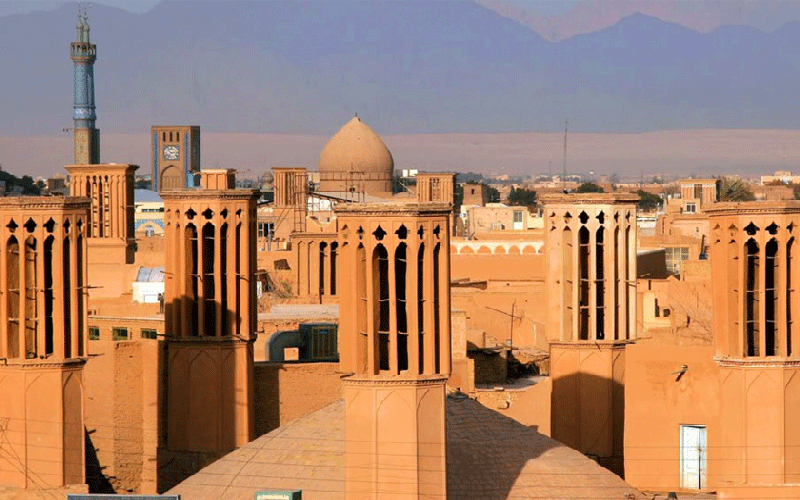
Cultural Diversity: Yazd’s historical role as a stop on the Silk Road has contributed to a diverse cultural and culinary heritage. The city’s bazaars are excellent places to experience this cultural diversity.
Traditional Cuisine: Yazd offers a unique taste of Persian cuisine, with local specialties such as sweets, kebabs, and stews showcasing the region’s culinary delights.
Windcatchers: Yazd’s windcatchers are iconic symbols of the city’s architectural ingenuity and can be fascinating for those interested in understanding how ancient civilizations adapted to harsh climates.
Water Museum: The Yazd Water Museum provides an educational experience about the ingenious qanat system, an ancient underground aqueduct network that has allowed the city to thrive in a desert environment.
Hospitality: Yazd is known for the warm and welcoming nature of its residents. Visitors often feel embraced by the city’s friendly population.
Desert Adventures: The surrounding desert offers opportunities for desert exploration, including camel riding and sand dune trekking, adding an element of adventure to your visit.
Historical Sites: Yazd is home to a range of historical sites, including the Amir Chakhmaq Complex and the Jameh Mosque, which showcase the city’s architectural and cultural heritage.
Ultimately, choosing Yazd as a travel destination provides the opportunity to explore Iran’s ancient history, Zoroastrian culture, and the architectural beauty of a desert city. The city’s unique blend of history, culture, and natural landscapes makes it an appealing destination for travelers looking for an authentic and immersive experience.
More information about Persepolis
Persepolis, also known as “Takht-e Jamshid,” is one of the most iconic and historically significant archaeological sites in Iran. It is located near the modern city of Shiraz in the Fars Province of Iran. Persepolis was the ceremonial capital of the Achaemenid Empire and is a UNESCO World Heritage Site. Here’s more information about Persepolis:
Historical Significance:
Persepolis was constructed during the reign of Darius the Great in the 6th century BCE and continued to be expanded by subsequent Achaemenid kings, including Xerxes I and Artaxerxes I. The city served as the ceremonial capital of the Achaemenid Empire, which was one of the largest and most powerful empires of its time.
Architectural Marvels:
The architecture of Persepolis is a testament to the advanced engineering and artistic achievements of the Achaemenid civilization. The city was designed to impress and host lavish celebrations, including royal receptions and festivals. Some of its key architectural features include:
Gate of All Nations: This monumental gate served as the main entrance to the city and was guarded by colossal human-headed winged bulls.
Apadana Palace: The Apadana Palace was a grand audience hall where kings received dignitaries and conducted official ceremonies. It features impressive stone columns, intricate carvings, and reliefs.
Tachara Palace: This smaller palace was likely a residence for the king. It is known for its exquisite stonework and details.
Hundred-Column Hall: Despite the name, this structure had 72 columns and was used for various functions, including banquets and receptions.
Staircases and Bas-Reliefs: Persepolis is adorned with a vast number of intricate bas-reliefs and carvings that depict various aspects of life, including royal processions, tribute-bearing delegations, and mythological scenes.
Ceremonial Center:
Persepolis was used as a ceremonial and administrative center, rather than a residential city. It hosted elaborate celebrations, including the famous New Year festival, known as “Nowruz” in Persian, where representatives from various subject nations brought gifts and tributes to the Achaemenid king.
Alexander the Great’s Conquest:
In 330 BCE, Alexander the Great of Macedon captured Persepolis, which led to the eventual decline of the Achaemenid Empire. The city was partially destroyed by fire during Alexander’s conquest, and its ruins were buried under sand for centuries.
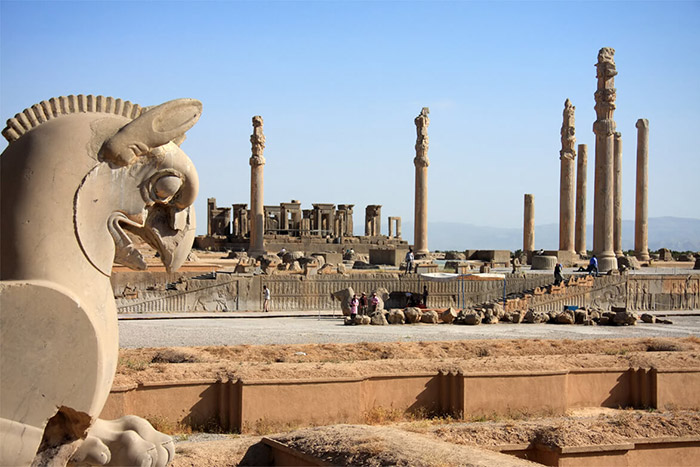
UNESCO World Heritage Site:
Persepolis was designated as a UNESCO World Heritage Site in 1979, recognizing its cultural and historical significance. It is a must-visit destination for history enthusiasts and travelers interested in ancient civilizations.
Today, Persepolis stands as a testament to the grandeur and architectural achievements of the Achaemenid Empire. It offers a glimpse into the past, allowing visitors to appreciate the art, culture, and history of one of the world’s most influential ancient civilizations.
why Persepolis
Visiting Persepolis is an extraordinary experience for a variety of compelling reasons:
Historical Significance: Persepolis was once the ceremonial capital of the Achaemenid Empire, one of the most powerful and influential empires in history. It provides a unique opportunity to explore the grandeur of an ancient civilization.
Architectural Marvels: The city’s architecture, with its grand gateways, palaces, columns, and intricate bas-reliefs, showcases the advanced engineering and artistic achievements of the Achaemenid civilization.
Cultural Insights: Persepolis offers valuable insights into the culture, traditions, and ceremonies of the Achaemenid Empire. It was the site of royal receptions, festivals, and gatherings attended by dignitaries and representatives from various nations.
Historical Mystique: The city’s history includes the conquest of Alexander the Great, which adds a layer of historical intrigue to the site.
UNESCO World Heritage Status: Persepolis is a UNESCO World Heritage Site, recognized for its cultural and historical significance. It is part of the world’s cultural heritage and is meticulously preserved.
Archaeological Exploration: Persepolis is an archaeological treasure trove, allowing visitors to witness ongoing excavations and learn about the process of uncovering ancient history.
Mythological Carvings: The site is adorned with numerous intricate carvings and bas-reliefs depicting mythological and historical scenes, offering a window into ancient storytelling.
Educational Value: For students and history enthusiasts, Persepolis provides a real-world classroom where you can learn about ancient empires, cultures, and architecture.
Photographic Opportunities: The city’s remarkable ruins, stunning architectural features, and desert backdrop offer excellent opportunities for photography.
Cultural Appreciation: Visiting Persepolis allows you to appreciate the rich cultural heritage of Iran and its role in shaping the ancient world.
Symbol of Resilience: The fact that Persepolis still stands as a testament to the enduring legacy of the Achaemenid Empire, despite the passage of millennia, is awe-inspiring.
Travel Adventure: Traveling to Persepolis takes you on a journey through history and the ancient world, making it a memorable and adventurous experience.
In summary, choosing to visit Persepolis provides an opportunity to step back in time, explore the remnants of a powerful ancient civilization, and immerse yourself in the history, culture, and artistry of the Achaemenid Empire. It’s a remarkable destination for anyone interested in the wonders of our shared human heritage.
More information about kashan
Kashan is a historic city in central Iran, situated between the cities of Tehran and Isfahan. It is known for its rich cultural heritage, traditional architecture, beautiful gardens, and the production of high-quality Persian carpets. Here’s more information about Kashan:
Historical Significance:
Kashan has a long history dating back to ancient times, with evidence of human settlement in the area for over 7,000 years. It has played a role in Iran’s history and culture over the centuries.
Historical Sites:
Kashan boasts numerous historical sites and architectural gems, including:
Fin Garden (Bagh-e Fin): A UNESCO World Heritage Site, this stunning Persian garden features beautiful pavilions, fountains, and canals. It’s a serene place to explore and relax.
Tabatabaei House: A well-preserved traditional Persian mansion showcasing the city’s architectural elegance, with its intricate stucco, stained glass windows, and beautiful courtyards.
Borujerdi House: Another magnificent historic house renowned for its architecture and design, including wind towers and decorative details.
Agha Bozorg Mosque and Madrasa: This complex combines a mosque and a theological school, featuring intricate tile work and stunning architectural details.
Kashan Bazaar: A bustling traditional bazaar where you can shop for local goods, spices, carpets, and textiles. It’s a great place to experience the local culture.
Sultan Amir Ahmad Bathhouse: A beautifully preserved bathhouse with stunning tile work and intricate architectural features.
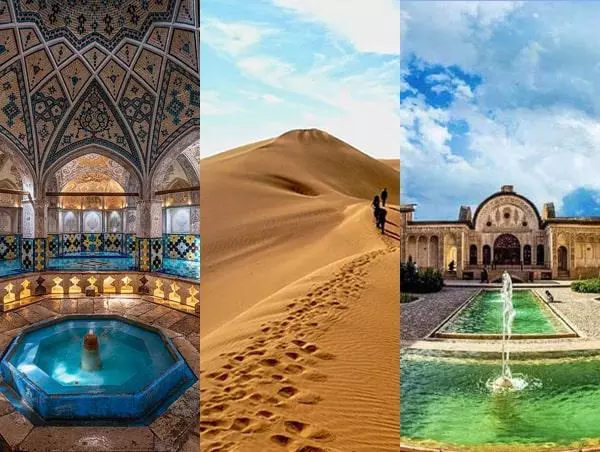
Traditional Craftsmanship:
Kashan is known for its production of high-quality Persian carpets and textiles. The city is a great place to shop for these traditional items, and you can often visit local workshops and witness the intricate weaving process.
Abyaneh Village:
Abyaneh is a picturesque village near Kashan known for its red mud-brick houses, traditional dress, and a rich cultural heritage. It offers a glimpse into the traditional lifestyle of rural Iran.
Culinary Delights:
Kashan offers a taste of delicious Persian cuisine. Local specialties include Kashan’s own version of Qombeh, a stuffed meatball, and various traditional Persian stews.
Rosewater Production:
Kashan is famous for its rosewater, which is made by distilling rose petals. The city’s rosewater is highly regarded and exported throughout Iran and beyond.
Silk and Textile Industry:
The city has a history of silk production and textiles, and you can explore local workshops to see the weaving process.
Geographical Location:
Kashan’s location between Tehran and Isfahan makes it a convenient stop for travelers en route to these major cities. It offers a pleasant and culturally rich break during a journey through Iran.
Kashan’s unique blend of history, architecture, gardens, craftsmanship, and traditional culture makes it a compelling destination for those interested in exploring Iran’s cultural and architectural heritage. It provides an authentic and immersive experience in a city that has preserved its traditions and historical sites over the years.
why kashan
Visiting Kashan can be a rewarding choice for travelers for various reasons:
Cultural and Architectural Heritage: Kashan is known for its rich cultural heritage and well-preserved traditional architecture. The city’s historic houses, gardens, and mosques showcase the elegance of Persian design and craftsmanship.
Historical Sites: Kashan boasts a variety of historical and cultural sites, including Fin Garden, Borujerdi House, Tabatabaei House, and Agha Bozorg Mosque and Madrasa, allowing visitors to explore the city’s history and artistic achievements.
Serene Gardens: The city’s gardens, especially Fin Garden, offer a serene escape from the hustle and bustle of urban life. These gardens are a testament to Persian gardening techniques and design.
Traditional Crafts: Kashan is a hub for the production of high-quality Persian carpets and textiles. Visitors can explore local workshops and learn about the intricate art of carpet weaving.
Local Bazaar: The city’s bazaar is a vibrant marketplace where you can shop for local goods, spices, and textiles. It’s an opportunity to experience the everyday life and culture of Kashan.
Culinary Delights: Kashan’s cuisine offers a taste of delicious Persian dishes. The city is known for its special version of Qombeh and various traditional stews.
Abyaneh Village: Nearby Abyaneh village is a unique cultural experience, known for its red mud-brick houses and traditional lifestyle. It offers a glimpse into rural Iranian culture.
Rosewater Production: Kashan is renowned for its production of high-quality rosewater, providing a chance to learn about and sample this fragrant product.
Silk and Textile Industry: The city has a history of silk production and textiles, and you can explore local workshops to see the weaving process and learn about this traditional industry.
Convenient Stop: Kashan’s location between Tehran and Isfahan makes it a convenient stop for travelers. It offers a pleasant break during a journey between these major cities.
Cultural Immersion: Traveling to Kashan allows you to immerse yourself in the authentic culture and history of Iran, providing a deeper understanding of the country’s heritage.
Ultimately, choosing Kashan as a travel destination provides an opportunity to explore Iran’s rich cultural and architectural heritage, experience its traditional way of life, and enjoy the serenity of its gardens and historic sites. It is a city that has preserved its traditions and historical treasures, making it a compelling destination for cultural enthusiasts and travelers seeking a genuine Iranian experience.
More information about mashhad
Mashhad is the second-largest city in Iran and the capital of Razavi Khorasan Province. It is a prominent religious and cultural center, known for its rich history, religious significance, and a range of attractions. Here’s more about Mashhad:
Religious Significance:
Mashhad is most renowned for being the holiest city in Iran and one of the most significant religious centers in the Shia Muslim world. The city is home to the Imam Reza Shrine, the shrine of the eighth Shia Imam, Imam Ali ibn Musa al-Reza. Pilgrims from Iran and around the world visit the shrine, making it a major pilgrimage site.
Imam Reza Shrine:
The Imam Reza Shrine is a vast and architecturally impressive complex, featuring golden domes, minarets, courtyards, and a museum. It serves as a religious and spiritual center, attracting millions of pilgrims and visitors each year. The shrine’s Goharshad Mosque is particularly renowned for its stunning tile work and calligraphy.
Historical Sites:
Mashhad has a rich history, and you can explore a variety of historical and cultural sites in the city:
Nader Shah Museum: This museum is dedicated to the life and reign of Nader Shah, a famous Iranian ruler known for his military conquests in the 18th century.
Tomb of Nader Shah: The tomb of Nader Shah, the founder of the Afsharid dynasty, is located in the city.
Khorasan Great Museum: This museum offers insights into the history, culture, and art of the Khorasan region.
Cultural Attractions:
Mashhad has a thriving cultural scene with theaters, art galleries, and music venues. You can explore contemporary Iranian art, music, and theater in the city.
Gastronomy:
Mashhad offers a wide variety of Persian dishes and local specialties. You can savor dishes like “Sholeh Mashhadi” (a local stew), “Qormeh Sabzi,” and various kebabs.
Shopping:
The city’s bustling bazaars, including the Bazaar Reza and Bazaar Shandiz, are great places to shop for souvenirs, textiles, spices, and traditional Iranian goods.
Natural Beauty:
Mashhad is surrounded by picturesque landscapes and natural attractions. You can explore the vast and beautiful landscapes of the Khorasan region, such as the Binalood Mountains and Torqabeh and Shandiz hills.
Educational and Research Institutions:
The city is home to several universities and educational institutions, making it a hub for academic and research activities.
Festivals and Cultural Events:
Mashhad hosts various cultural events, including religious festivals and cultural celebrations, offering a chance to experience the city’s vibrant atmosphere.
Hospitality:
Mashhad is known for its warm and hospitable residents, who welcome pilgrims and travelers with open arms.
Mashhad’s unique combination of religious significance, cultural attractions, and historical sites makes it a captivating destination for those interested in exploring Iran’s rich spiritual and cultural heritage. Whether you visit for religious reasons or to experience the city’s diverse culture and history, Mashhad offers a memorable and enlightening journey.

why mashhad
Mashhad is a compelling destination for several reasons, making it an appealing choice for travelers:
Religious Significance: Mashhad is home to the Imam Reza Shrine, one of the holiest sites in Shia Islam. Pilgrims from all over the world visit this shrine, making it a profound and spiritual destination for those seeking a religious and cultural experience.
Architectural Marvel: The Imam Reza Shrine is a magnificent architectural masterpiece with its golden domes, stunning tile work, and grand courtyards. It offers a visual and spiritual spectacle.
Historical Sites: Mashhad has a rich history and offers a range of historical and cultural sites, including museums, Nader Shah’s tomb, and historical landmarks, providing insights into Iran’s past.
Cultural Exploration: The city has a vibrant cultural scene, with theaters, art galleries, music venues, and cultural festivals that allow travelers to engage with contemporary Iranian art and traditions.
Gastronomy: Mashhad offers a diverse range of Persian cuisine, including local specialties. It’s an opportunity to savor authentic Iranian dishes and culinary delights.
Natural Beauty: The city is surrounded by scenic natural landscapes, providing opportunities for hiking and outdoor activities. The Binalood Mountains, in particular, offer picturesque vistas.
Educational and Research Opportunities: Mashhad is home to universities and academic institutions, which can be of interest to students, scholars, and researchers.
Shopping: The city’s vibrant bazaars are ideal places to shop for local goods, textiles, spices, and traditional Iranian products.
Cultural Events: Mashhad hosts various cultural events and festivals, allowing travelers to immerse themselves in the city’s dynamic atmosphere.
Warm Hospitality: The people of Mashhad are known for their warm and welcoming nature, ensuring that visitors feel embraced and appreciated.
Ultimately, choosing Mashhad as a travel destination depends on one’s interests and objectives. For those with a religious or spiritual inclination, it’s a profound pilgrimage site. For cultural and historical enthusiasts, it offers a wealth of experiences and attractions. Mashhad’s unique blend of religious significance, cultural richness, and historical charm makes it a compelling destination for those seeking to explore Iran’s diverse cultural tapestry.
More information about kerman
Kerman is a historical and culturally rich city located in southeastern Iran. It is the capital of Kerman Province and one of the oldest cities in Iran, with a history dating back over 2,000 years. Here’s more information about Kerman:
Historical Significance:
Kerman is known for its historical significance and played a pivotal role in the history of Iran, serving as a major center for trade, culture, and learning. The city has been mentioned in ancient texts and has seen the rise and fall of various dynasties over the centuries.
Historical Sites and Landmarks:
Kerman boasts a wide range of historical sites and architectural marvels, including:
Ganjali Khan Complex: This impressive historical complex features a bathhouse, mosque, bazaar, and caravanserai. It’s a beautiful example of Persian architecture and design.
Jameh Mosque of Kerman: This mosque is a significant religious and architectural landmark, with its stunning tile work and intricate decorations.
Gonbad-e Jabaliyeh: An ancient brick dome believed to date back to the Seljuk era, it is a notable architectural structure.
Mahan: A nearby town, Mahan is known for its beautiful Bagh-e Shazdeh (Prince’s Garden) and the Shah Nematollah Vali Shrine.
Shahdad Desert: Kerman is close to the Shahdad Desert, a vast and stunning desert landscape featuring unique geological formations and the world’s hottest spot.
Cultural Heritage:
Kerman is a city with a rich cultural heritage. The people of Kerman are known for their hospitality and have preserved their local traditions and customs over the years.
Gastronomy:
Kerman’s cuisine includes a variety of Persian dishes and local specialties. One popular local dish is “Qeymeh Kermani,” a type of stew made with split peas and lamb.
Carpets and Handicrafts:
Kerman is famous for its production of high-quality Persian carpets, which are renowned for their intricate designs and craftsmanship. You can visit local carpet workshops and shops.
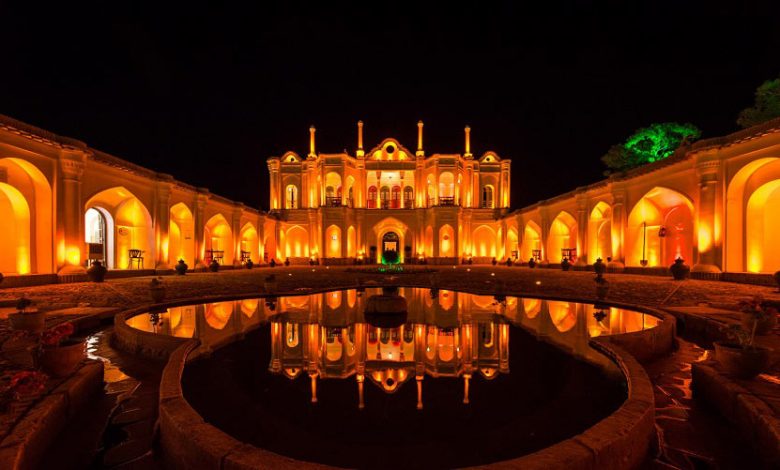
Natural Beauty:
The city is surrounded by natural beauty. The Lut Desert, a UNESCO World Heritage Site, is nearby and offers a unique and otherworldly landscape.
Historical and Cultural Museums:
Kerman is home to various museums, including the Kerman National Museum and the Kerman Postal Museum, which showcase the region’s history and cultural heritage.
Souvenirs and Shopping:
The city’s bazaars are great places to shop for souvenirs, including carpets, textiles, and handicrafts.
Religious Sites:
Kerman is home to numerous mosques, shrines, and religious sites, providing an opportunity for spiritual reflection and exploration.
Kerman’s unique blend of history, architecture, culture, and natural beauty makes it a compelling destination for travelers looking to explore Iran’s rich heritage. Whether you’re interested in historical landmarks, Persian carpets, desert landscapes, or cultural immersion, Kerman offers a diverse range of experiences to discover and enjoy.
why kerman
Visiting Kerman can be a captivating choice for travelers for a variety of reasons:
Historical Significance: Kerman is one of the oldest cities in Iran, with a rich and diverse history spanning over 2,000 years. It has been a center of culture, trade, and learning, making it a fascinating destination for history enthusiasts.
Architectural Marvels: The city boasts stunning architectural landmarks such as the Ganjali Khan Complex, Jameh Mosque of Kerman, Gonbad-e Jabaliyeh, and more. These structures showcase the intricacy and artistry of Persian architecture.
Cultural Heritage: Kerman has preserved its cultural traditions, making it an ideal place to experience authentic Iranian customs and local hospitality.
Natural Beauty: The city is surrounded by breathtaking natural landscapes, including the unique and otherworldly Lut Desert. The opportunity to explore this extraordinary desert environment can be an adventure for nature and photography enthusiasts.
Gastronomy: Kerman offers a variety of Persian dishes and local specialties. Tasting the local cuisine, including Qeymeh Kermani, allows you to savor the region’s culinary delights.
Carpets and Handicrafts: Kerman is renowned for its high-quality Persian carpets and handicrafts, offering opportunities to explore and purchase exquisite traditional products.
Historical and Cultural Museums: Kerman’s museums provide insights into the region’s history, culture, and artistic heritage.
Religious Sites: The city features numerous mosques, shrines, and religious sites that offer spiritual reflection and a chance to explore Iran’s religious and cultural traditions.
Shopping: The city’s vibrant bazaars are great places to shop for souvenirs, textiles, spices, and other traditional Iranian goods.
UNESCO World Heritage: The Lut Desert, located near Kerman, is a UNESCO World Heritage Site and offers travelers a chance to explore the world’s hottest spot and its unique geological formations.
Hospitality: The people of Kerman are known for their warm and hospitable nature, ensuring that visitors feel welcome and appreciated.
Ultimately, Kerman is an attractive destination for those seeking to explore a city with a rich history, impressive architecture, a range of cultural experiences, and stunning natural landscapes. Whether you’re interested in history, architecture, culture, or nature, Kerman provides a diverse and rewarding travel experience.
More information about kermanshah
Kermanshah is a city located in western Iran and is the capital of Kermanshah Province. It is known for its historical significance, cultural heritage, and natural beauty. Here’s more information about Kermanshah:
Historical Significance:
Kermanshah has a rich history, with evidence of human settlement dating back thousands of years. The city has been influenced by various civilizations, including the Medes and the Parthians. Its historical sites and landmarks reflect this diverse heritage.
Historical and Cultural Sites:
Kermanshah boasts several historical and cultural attractions:
Taq-e Bostan: This ancient site features rock reliefs and historic carvings on large stone walls, depicting scenes from the Sassanid Empire. It’s a valuable source of historical insight.
Bisotun: Located just outside Kermanshah, Bisotun is a UNESCO World Heritage Site and home to a large rock relief and inscription created by Darius the Great. The inscription is written in three languages: Old Persian, Elamite, and Babylonian.
Tekyeh Moaven al-Molk: This religious structure is known for its impressive architecture and intricate tile work. It is a place of worship and cultural significance.
Cultural Heritage:
Kermanshah is known for its vibrant Kurdish culture, with many local traditions and customs, including music, dance, and handicrafts. The city is a hub for traditional Kurdish arts and crafts.
Natural Beauty:
The surrounding region of Kermanshah is characterized by its natural beauty, with mountains, valleys, and lush landscapes. The picturesque Sahneh and Sarpol-e Zahab regions are known for their stunning scenery.
Archaeological Sites:
Kermanshah Province is home to various archaeological sites, including ancient settlements, burial mounds, and artifacts, providing insights into the region’s ancient history.
Religious Sites:
Kermanshah features numerous mosques, shrines, and religious sites that are of historical and cultural significance, such as the Jameh Mosque of Kermanshah.
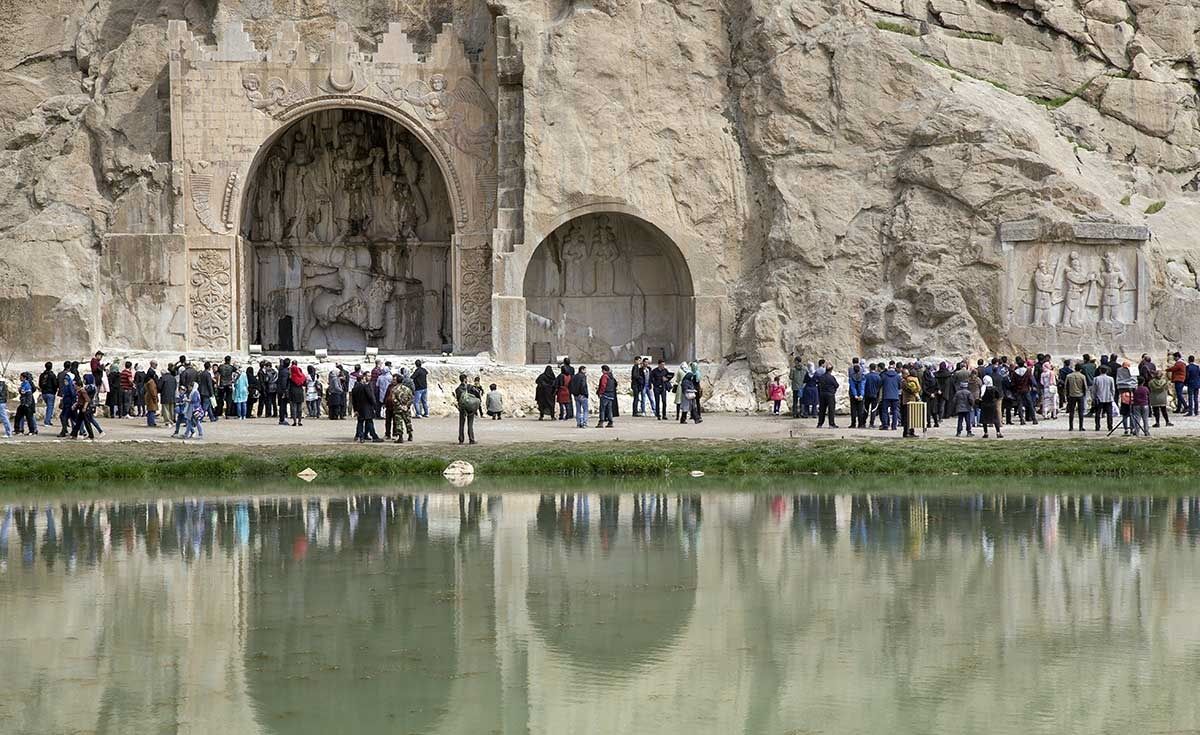
Cuisine:
Kermanshah offers a taste of traditional Kurdish cuisine, which includes dishes like “Kabab Koobideh” (grilled minced meat), rice dishes, and a variety of flavorful stews.
Hospitality:
The people of Kermanshah are known for their warm and welcoming nature, making visitors feel at home and providing a glimpse into Kurdish hospitality.
Shopping:
The city’s bazaars are great places to shop for local goods, handicrafts, textiles, and traditional Kurdish products.
Festivals and Cultural Events:
Kermanshah hosts various cultural events and festivals that celebrate the region’s heritage, music, and dance traditions.
Educational and Research Institutions:
Kermanshah is home to universities and educational institutions, contributing to academic and research activities.
Kermanshah’s unique blend of historical sites, cultural heritage, natural beauty, and Kurdish traditions makes it an appealing destination for travelers interested in exploring Iran’s western regions. Whether you’re fascinated by history, cultural diversity, nature, or local traditions, Kermanshah offers a range of experiences to discover and enjoy.
why kermanshah
Visiting Kermanshah can be an enriching experience for several reasons:
Historical Significance: Kermanshah is steeped in history, with notable historical sites like Taq-e Bostan and Bisotun that offer a glimpse into Iran’s ancient past.
Cultural Heritage: The city is a hub for Kurdish culture, which is rich in music, dance, and traditional arts. Exploring this culture can provide a unique and authentic experience.
Archaeological Sites: The province surrounding Kermanshah contains numerous archaeological sites, allowing you to discover ancient civilizations and historical artifacts.
Natural Beauty: The region is known for its stunning natural landscapes, including mountains, valleys, and lush green areas, making it a great destination for nature lovers and hikers.
UNESCO World Heritage: The presence of UNESCO World Heritage Sites like Bisotun showcases the city’s historical significance and adds to its allure.
Cuisine: Kermanshah offers a taste of traditional Kurdish cuisine, providing an opportunity to savor regional specialties and flavors.
Hospitality: The warm and welcoming nature of the local people provides an opportunity to engage with Kurdish hospitality and traditions.
Cultural Festivals: Kermanshah hosts various cultural events and festivals that celebrate Kurdish heritage, music, and dance.
Shopping: The city’s bazaars are excellent places to shop for local goods, textiles, handicrafts, and traditional Kurdish products.
Educational and Research Institutions: Kermanshah’s educational and research institutions contribute to academic and research activities, making it an interesting destination for scholars and students.
Ultimately, choosing to visit Kermanshah depends on your interests. If you are intrigued by history, culture, natural beauty, and the chance to explore lesser-known regions of Iran, Kermanshah offers a unique and rewarding travel experience. It allows you to discover the rich cultural tapestry and historical depth of this region, making it a memorable destination for explorers seeking a genuine and off-the-beaten-path experience.
More information about qazvin
Qazvin is a city located in northwestern Iran and is the capital of Qazvin Province. It has a rich historical and cultural heritage, making it an interesting destination for travelers. Here’s more information about Qazvin:
Historical Significance:
Qazvin has a history that spans over 2,000 years and has played a significant role in various historical periods. It was the capital of the Safavid Empire for a brief time during the 16th century.
Historical and Cultural Sites:
Qazvin boasts several historical and cultural attractions:
Qazvin Bazaar: The city’s grand bazaar is one of the oldest and most significant in Iran, with its maze of lanes and chambers filled with merchants and stalls. It’s a great place to shop for local goods.
Imamzadeh Hossein: A pilgrimage site with a stunning blue dome and intricate tile work. It’s a place of religious and architectural significance.
Aminiha Hosseiniyeh: A historical complex with a mosque, library, and a traditional teahouse. The complex showcases Qazvin’s architecture and cultural heritage.
Cantor Church (Holy Savior Cathedral): An Armenian Apostolic Church known for its beautiful architecture and historical importance.
Natural Beauty:
Qazvin is surrounded by picturesque landscapes and natural attractions, making it an appealing destination for nature enthusiasts. The Alborz Mountains provide a stunning backdrop.
Cuisine:
Qazvin offers a taste of delicious Persian dishes and local specialties. Local food options include “Zeytoon Parvardeh” and various kebabs.
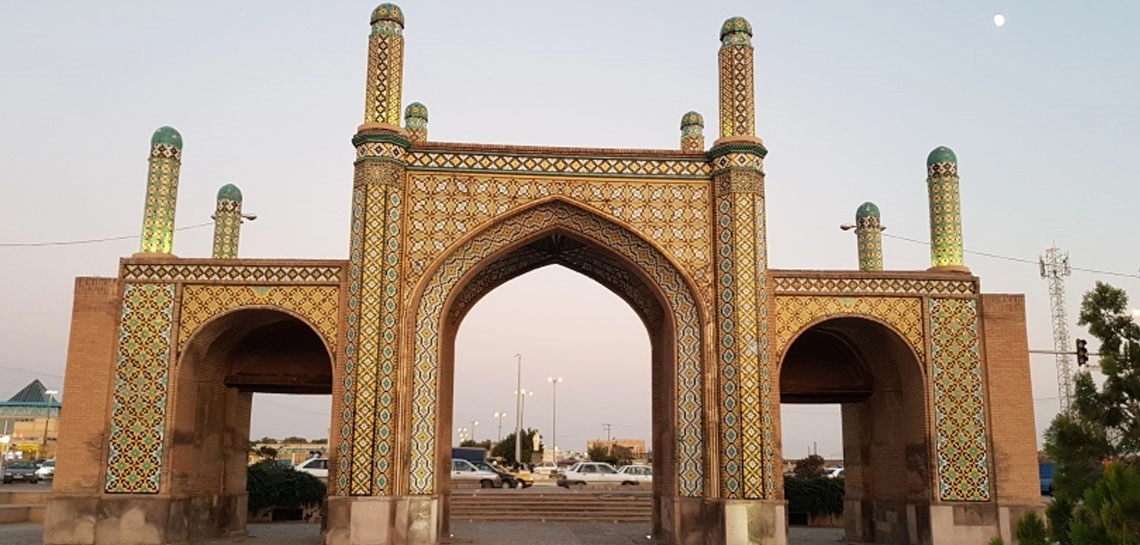
Cultural Heritage:
Qazvin has a rich cultural heritage, and the city is known for its music, poetry, and calligraphy. Traditional Persian arts are still practiced and celebrated in the city.
Hospitality:
The people of Qazvin are known for their warm and friendly nature, providing a welcoming atmosphere for travelers.
Shopping:
The city’s bazaars are great places to shop for local goods, spices, textiles, handicrafts, and traditional Iranian products.
Educational and Research Institutions:
Qazvin is home to universities and educational institutions, making it a center for academic and research activities.
Festivals and Cultural Events:
The city hosts various cultural events and festivals, allowing travelers to experience Qazvin’s vibrant atmosphere and cultural traditions.
Religious Sites:
Qazvin features numerous mosques, shrines, and religious sites that are of historical and cultural significance.
Qazvin’s unique blend of historical sites, cultural heritage, natural beauty, and warm hospitality makes it an attractive destination for those interested in exploring Iran’s cultural tapestry. Whether you’re intrigued by history, architecture, culture, nature, or local traditions, Qazvin offers a diverse range of experiences to discover and enjoy.
why qazvin
Qazvin is an intriguing destination for various reasons, making it an attractive choice for travelers:
Historical Significance: Qazvin boasts a history that spans over two millennia, with deep-rooted historical and cultural significance. It has been the capital of empires and played a pivotal role in Iran’s history.
Historical and Cultural Sites: The city offers numerous historical and cultural attractions, including its grand bazaar, religious shrines, and well-preserved architectural gems. These sites provide a glimpse into Iran’s rich past.
Cultural Heritage: Qazvin has a rich cultural heritage, known for its music, poetry, and traditional arts. It’s an ideal place to immerse yourself in Persian culture and customs.
Natural Beauty: The city is surrounded by picturesque landscapes, with the Alborz Mountains as a stunning backdrop. Nature enthusiasts can explore the scenic beauty of the region.
Cuisine: Qazvin offers a taste of Persian cuisine and local specialties. Trying regional dishes allows you to savor the flavors of the area.
Cultural Events: The city hosts various cultural events and festivals, providing an opportunity to experience Qazvin’s vibrant atmosphere and local traditions.
Shopping: Qazvin’s bazaars are bustling centers for shopping, offering a wide range of local goods, textiles, spices, and traditional Iranian products.
Educational and Research Institutions: The city is home to universities and educational institutions, contributing to academic and research activities.
Hospitality: The people of Qazvin are known for their warm and friendly nature, creating a welcoming and hospitable atmosphere for travelers.
Convenience: Qazvin’s location, not far from Tehran, makes it a convenient stop for travelers exploring Iran’s northern regions, including the Caspian Sea and the Alborz Mountains.
Ultimately, choosing to visit Qazvin depends on your interests. Whether you’re drawn to history, architecture, culture, nature, or local traditions, Qazvin provides a range of experiences to explore and enjoy. It allows you to immerse yourself in Iran’s rich cultural tapestry and historical depth, making it a memorable destination for travelers seeking an authentic Iranian experience.

